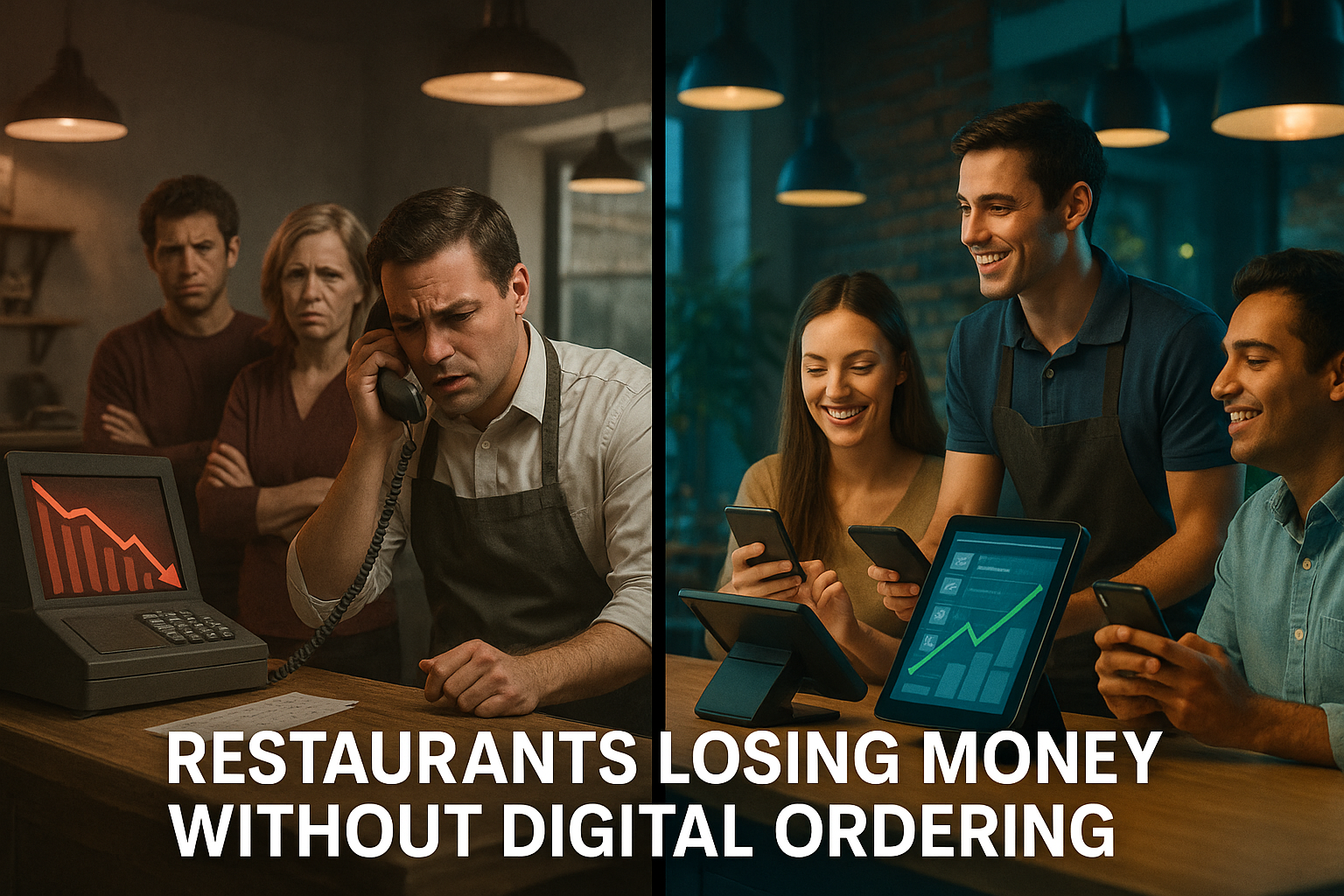In today's rapidly evolving restaurant landscape, the absence of digital ordering isn't just an inconvenience—it's a profit killer. While many restaurant owners focus on perfecting their recipes and ambiance, they're unknowingly hemorrhaging revenue by failing to embrace the digital transformation that has become essential for survival and growth.
The harsh reality is that restaurants without digital ordering systems are losing money in ways they may not even realize. From missed sales opportunities to operational inefficiencies, the cost of staying offline extends far beyond the obvious. This comprehensive analysis reveals the hidden financial impact of not having digital ordering and why every restaurant owner should treat this as an urgent business priority.
The Staggering Financial Impact: By the Numbers
The statistics paint a sobering picture for restaurants that haven't embraced digital ordering. According to recent industry data, restaurants with online ordering systems can raise their takeout profits by 30% higher than those without. This isn't a marginal improvement—it's a game-changing difference that can determine whether a restaurant thrives or merely survives.
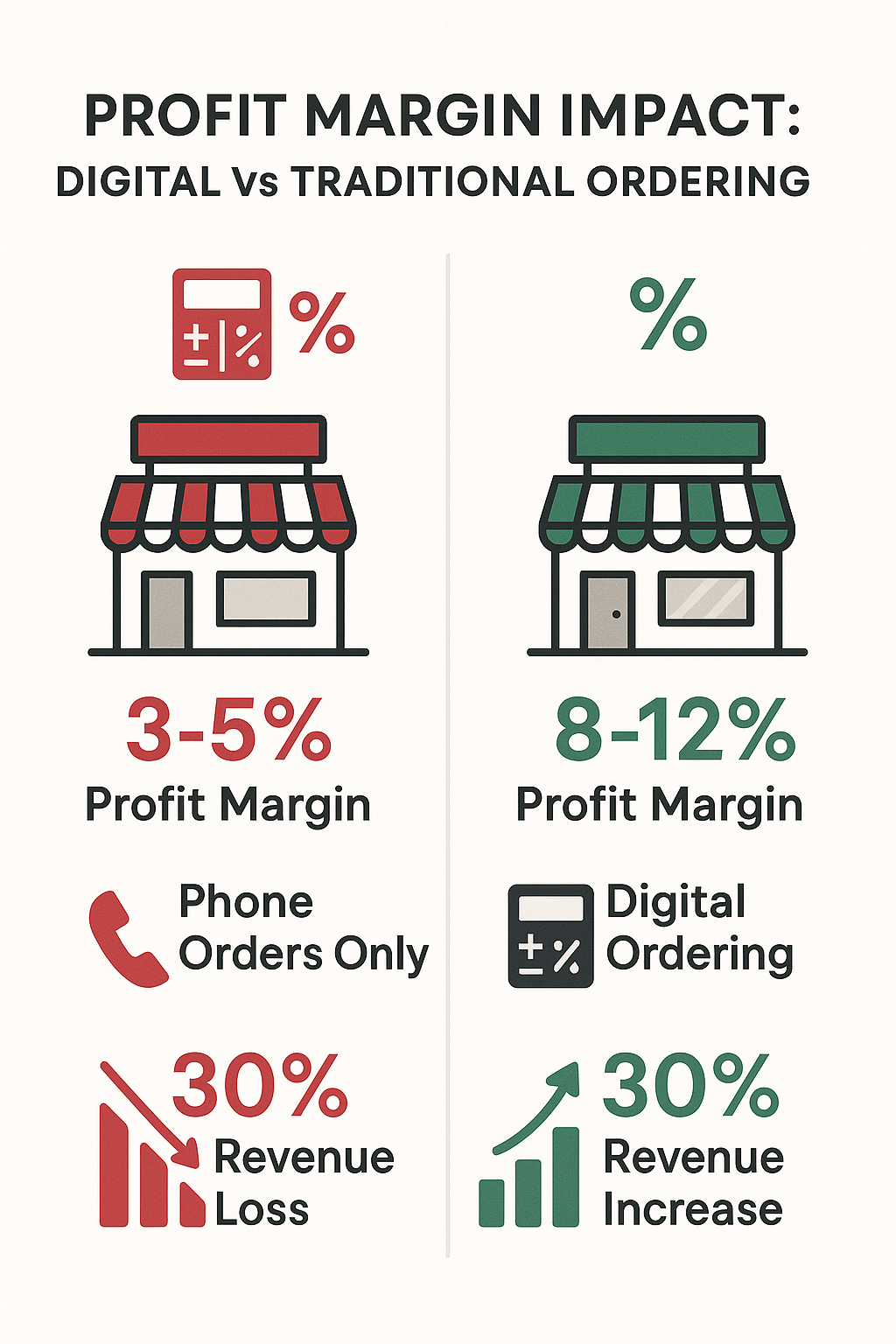
Consider the mathematics of this revenue gap. For a restaurant generating $50,000 in monthly takeout revenue, implementing digital ordering could potentially increase that figure to $65,000—an additional $15,000 per month or $180,000 annually. For many restaurants operating on thin margins, this difference represents the gap between profitability and financial struggle.
But the revenue impact extends beyond simple percentage increases. Restaurants with proper digital ordering systems report:
•75% more conversions from browsing to actual orders
•15% increase in average check size through strategic upselling
•33% more returning customers due to improved convenience and experience
These numbers compound over time, creating a widening gap between digitally-enabled restaurants and those still relying on traditional ordering methods.
The Third-Party Platform Trap: Why Relying on Aggregators Costs More Than You Think
Many restaurant owners believe they've solved the digital ordering challenge by listing on third-party delivery platforms like DoorDash, Uber Eats, or Grubhub. However, this approach often creates more financial problems than it solves.
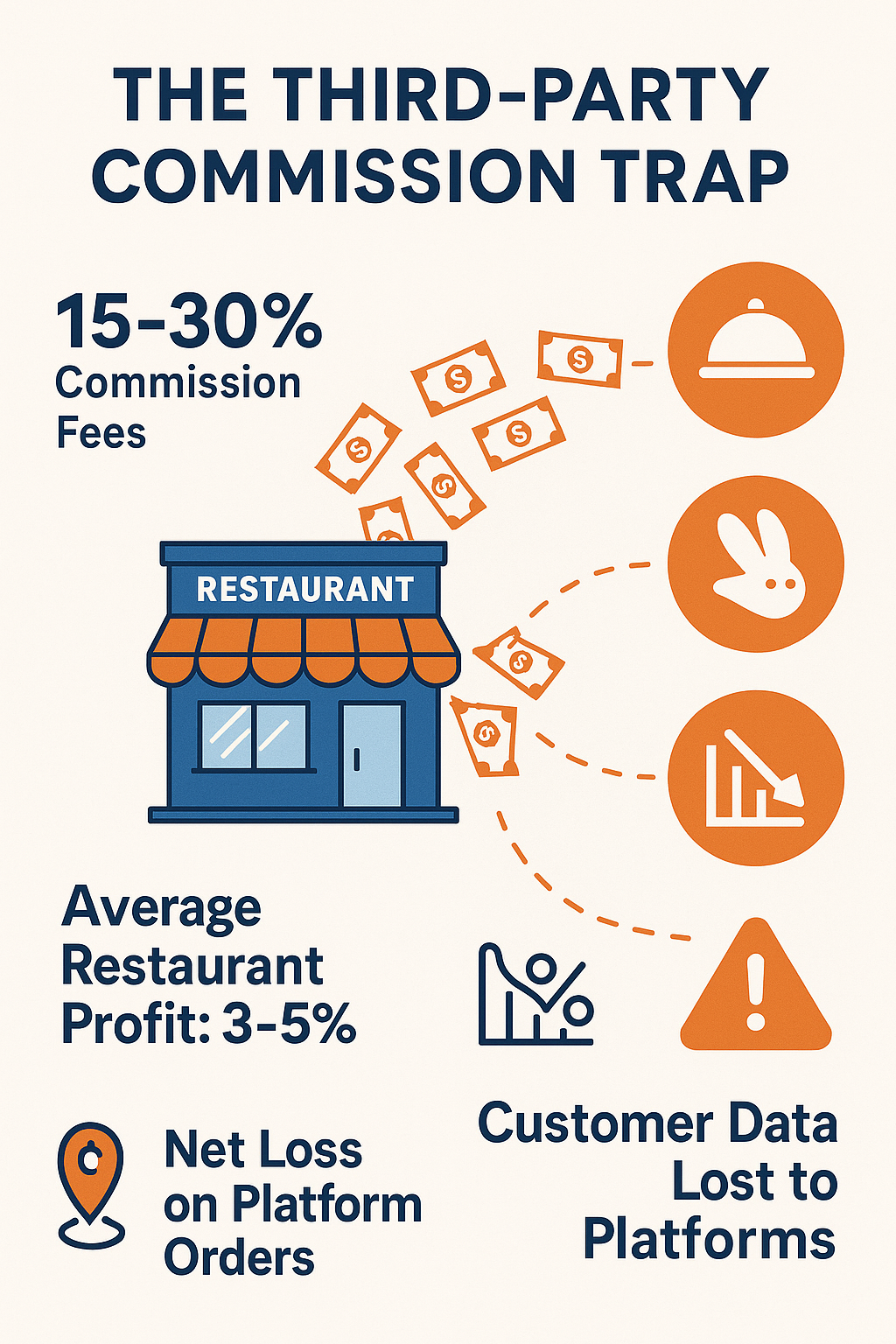
The Commission Nightmare
Third-party platforms typically charge commission fees ranging from 15% to 30% of gross sales. For restaurants already operating on razor-thin margins—with full-service establishments averaging just 3-5% profit margins and fast-casual restaurants managing 6-9%—these fees can be devastating.
Here's the brutal math: If your restaurant has a 10% net profit margin and you're paying 25% commission to a delivery platform, you're essentially operating at a 15% loss on every order. The only way to maintain profitability is to raise prices significantly, which often makes you less competitive and drives customers away.
The Customer Data Dilemma
Perhaps even more damaging than the immediate commission costs is the long-term impact of customer data loss. When customers order through third-party platforms, restaurants lose access to crucial information including:
•Customer contact details and ordering history
•Preferences and dietary restrictions
•Frequency of orders and spending patterns
•Opportunities for direct marketing and retention campaigns
This data represents the foundation of customer relationship management and long-term business growth. Without it, restaurants become entirely dependent on external platforms for customer acquisition and retention, creating a dangerous vulnerability in their business model.
The Hidden Costs of Phone-Only Ordering
Restaurants that rely exclusively on phone orders face a unique set of challenges that directly impact their bottom line. While phone ordering might seem cost-effective, the hidden expenses quickly add up.
Labor Inefficiency and Opportunity Cost
Every minute your staff spends taking phone orders is time not spent on food preparation, customer service, or other revenue-generating activities. During peak hours, this becomes particularly problematic as phone lines become overwhelmed and potential customers receive busy signals or are placed on hold.
Industry research indicates that unanswered phone calls represent significant revenue loss for restaurants. A single unanswered call during lunch rush could represent a $25-50 lost order. Multiply this by several calls per day, and the annual impact can reach tens of thousands of dollars in lost revenue.
Order Accuracy and Customer Satisfaction
Phone orders are inherently prone to human error. Miscommunication about menu items, special requests, or contact information leads to:
•Incorrect orders requiring remakes (food cost and labor)
•Customer dissatisfaction and negative reviews
•Refunds and compensation costs
•Lost repeat business
Digital ordering systems eliminate these communication barriers, ensuring that customers receive exactly what they ordered while reducing the operational costs associated with mistakes.
The Competitive Disadvantage: Losing Customers to Digital-First Competitors
In today's market, customer expectations have fundamentally shifted. Modern diners don't just want good food—they demand convenience, speed, and seamless experiences. Restaurants without digital ordering find themselves at a severe competitive disadvantage.
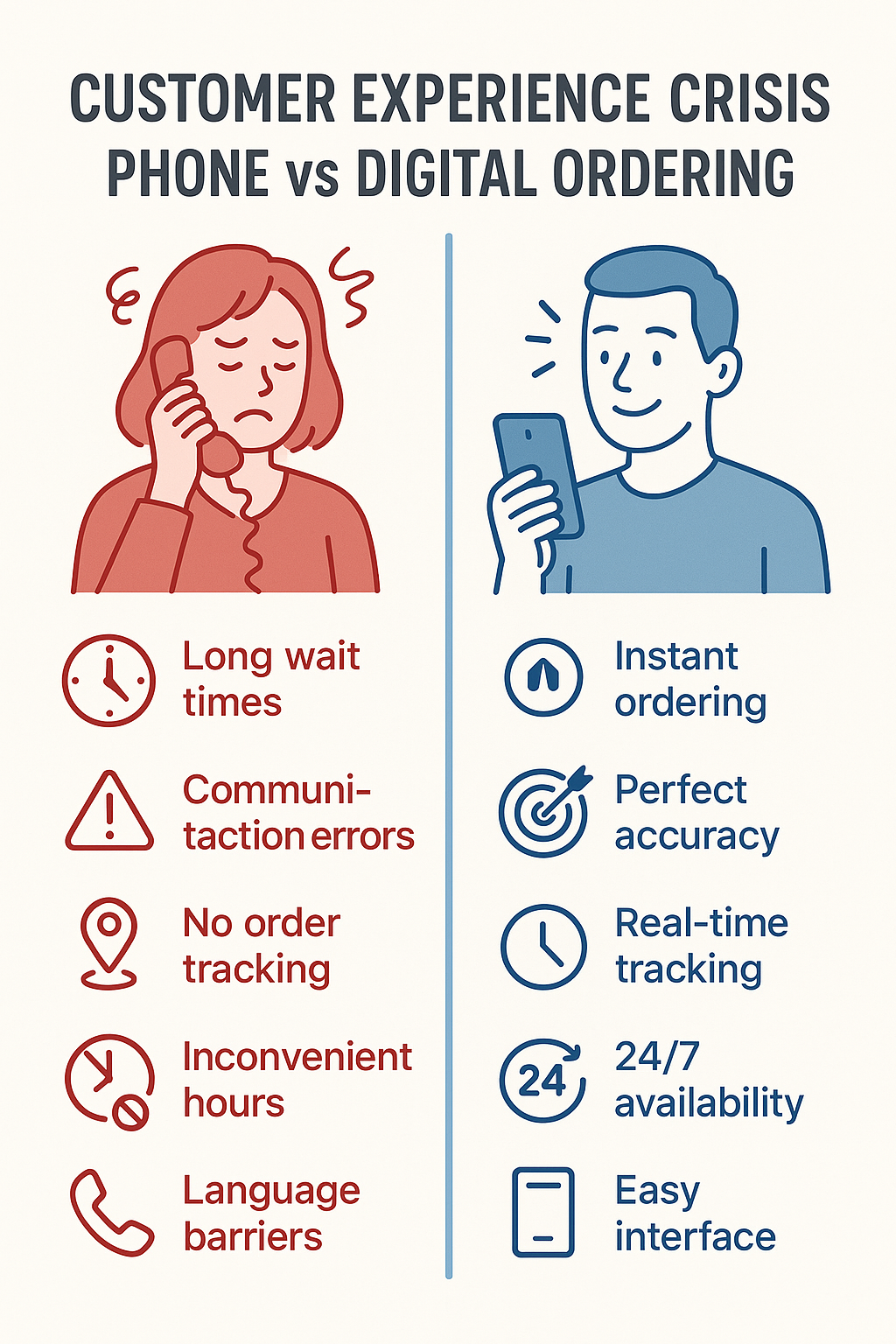
The Convenience Factor
When customers crave a particular cuisine or meal, they increasingly turn to the most convenient option available. If your restaurant requires a phone call while your competitor offers one-click ordering through their app or website, guess who gets the business?
This convenience factor becomes even more critical during:
•Peak dining hours when phone lines are busy
•Late-night ordering when customers prefer not to call
•Group orders that are complex to communicate over the phone
•Repeat orders where customers want to quickly reorder favorites
Brand Perception and Market Positioning
Restaurants without digital ordering increasingly appear outdated and out of touch with modern customer needs. This perception affects:
•Customer acquisition: Younger demographics may dismiss restaurants without digital options
•Market positioning: Competitors with digital ordering appear more professional and customer-focused
•Word-of-mouth marketing: Customers are less likely to recommend restaurants with inconvenient ordering processes
•Online reviews: Lack of digital ordering often receives negative mentions in customer feedback
The Operational Inefficiencies That Drain Profits
Beyond direct revenue loss, restaurants without digital ordering suffer from numerous operational inefficiencies that compound their financial challenges.
Inventory Management Challenges
Phone-based ordering makes it difficult to manage inventory in real-time. Staff may continue taking orders for items that are out of stock, leading to:
•Customer disappointment and cancellations
•Time wasted on order modifications
•Potential loss of the entire order when substitutions aren't acceptable
•Negative impact on customer experience and reviews
Digital ordering systems can integrate with inventory management, automatically removing unavailable items and suggesting alternatives, creating a smoother experience for both customers and staff.
Peak Hour Bottlenecks
During busy periods, phone-only restaurants face severe bottlenecks that limit their revenue potential. While digital ordering systems can handle unlimited simultaneous orders, phone systems create artificial capacity constraints that directly limit sales volume.
A restaurant that could potentially serve 100 orders during lunch rush might only manage 60 due to phone ordering limitations. This represents a 40% reduction in potential revenue during the most profitable hours of the day.
Staff Allocation and Productivity
Restaurants without digital ordering must dedicate significant staff time to order-taking activities. This creates several problems:
•Reduced kitchen efficiency: Staff pulled away from food preparation
•Inconsistent customer service: Front-of-house staff distracted by phone orders
•Higher labor costs: Need for additional staff to handle phone volume
•Training complexity: Staff must master both food service and order-taking skills
The Marketing and Customer Retention Deficit
Digital ordering systems provide restaurants with powerful marketing and customer retention tools that phone-only establishments simply cannot access.
Lost Upselling Opportunities
Digital ordering platforms excel at strategic upselling through:
•Automated suggestions: "Would you like to add dessert?"
•Bundle offers: Meal deals and combination packages
•Personalized recommendations: Based on order history
•Limited-time promotions: Targeted offers to increase order value
Phone orders rely entirely on staff memory and training for upselling, which is inconsistent and often forgotten during busy periods. The 15% increase in average check size that digital ordering provides largely comes from these systematic upselling opportunities.
Customer Loyalty and Retention Programs
Without digital ordering, restaurants cannot effectively implement:
•Points-based loyalty programs
•Personalized promotions and discounts
•Birthday and anniversary offers
•Targeted email marketing campaigns
•Customer feedback collection and response
These retention tools are crucial for long-term profitability, as acquiring new customers costs significantly more than retaining existing ones.
The Scalability Problem: Growth Limitations Without Digital Infrastructure
Restaurants without digital ordering face fundamental scalability challenges that limit their growth potential.
Geographic Expansion Difficulties
Opening new locations becomes more complex without digital ordering infrastructure because:
•Each location requires separate phone systems and staff training
•Marketing efforts must be duplicated for each location
•Customer data cannot be shared across locations
•Operational consistency becomes harder to maintain
Franchise and Multi-Location Challenges
For restaurants considering franchising or multiple locations, digital ordering becomes essential for:
•Standardized operations across all locations
•Centralized marketing and customer management
•Consistent pricing and menu management
•Performance tracking and optimization
Seasonal and Demand Fluctuations
Restaurants without digital ordering struggle to adapt to:
•Sudden demand spikes that overwhelm phone systems
•Seasonal menu changes that require staff retraining
•Promotional campaigns that increase order volume
•Special events that drive temporary demand increases
The Real Cost Analysis: What Restaurants Are Actually Losing
To understand the true financial impact of not having digital ordering, let's examine a realistic scenario based on industry data and research findings.
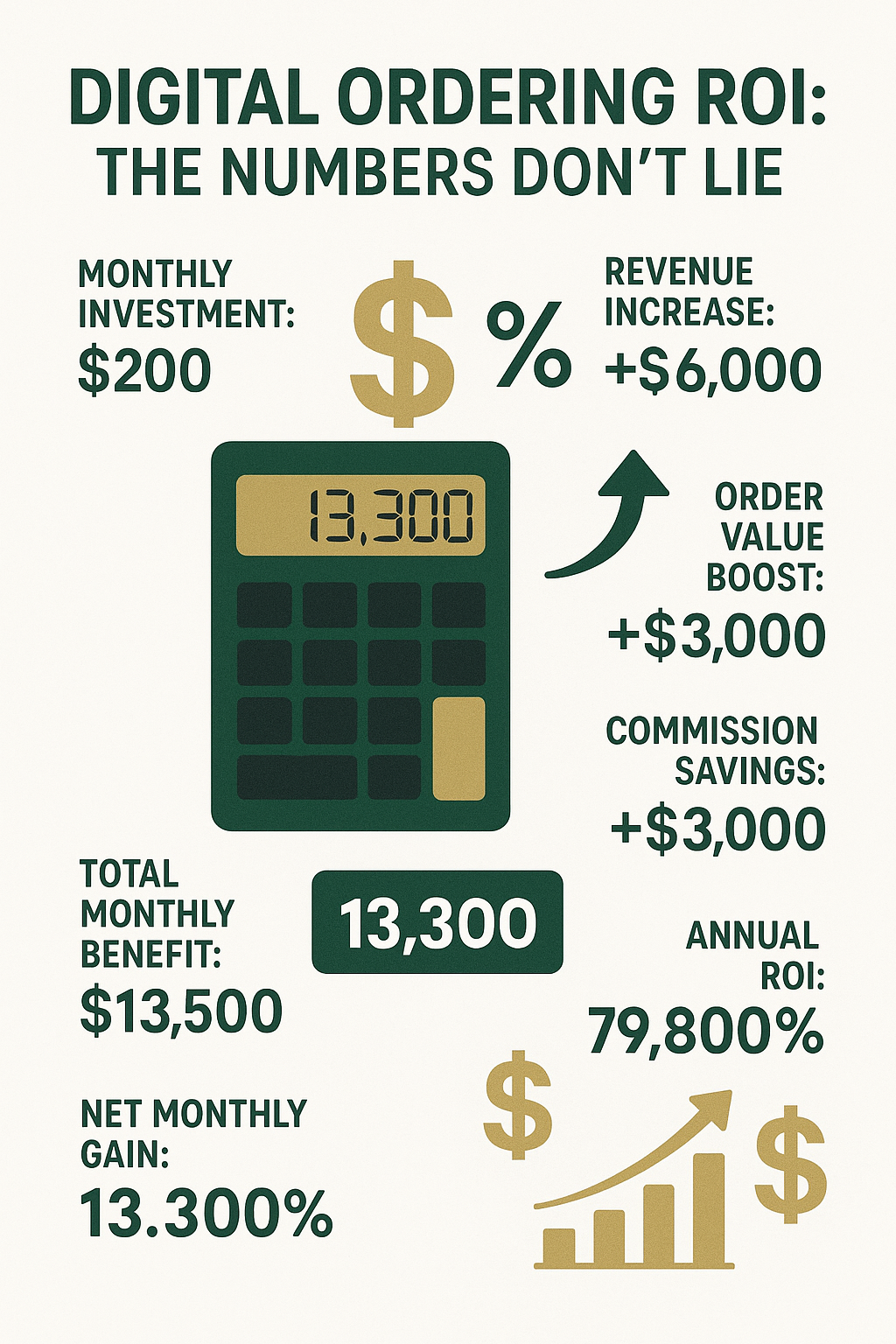
Case Study: Mid-Size Restaurant Financial Impact
Consider a typical mid-size restaurant with the following characteristics:
•Monthly revenue: $75,000
•Takeout/delivery portion: 40% ($30,000)
•Current profit margin: 8%
•Average order value: $35
•Monthly order volume: 857 orders
Without Digital Ordering:
•Monthly takeout revenue: $30,000
•Monthly profit from takeout: $2,400 (8%)
•Lost revenue from unanswered calls: $3,000 (10% of potential orders)
•Third-party platform commissions: $6,000 (20% of platform orders)
•Net monthly profit impact: -$6,600
With Digital Ordering:
•Increased takeout revenue (30% boost): $39,000
•Higher average order value (15% increase): $45,500
•Reduced operational costs: $1,500 savings
•Eliminated third-party commissions: $6,000 savings
•Net monthly profit improvement: +$22,000
Annual Impact: The difference between these scenarios represents approximately $342,000 in annual revenue impact—a figure that could transform a struggling restaurant into a thriving business.
The Compound Effect of Lost Opportunities
The financial impact of not having digital ordering compounds over time through several mechanisms:
Customer Lifetime Value Erosion: Without digital ordering, restaurants lose customers to competitors, reducing the lifetime value of their customer base. A customer who might have ordered 24 times per year becomes a zero-value customer when they switch to a more convenient competitor.
Market Share Decline: As more restaurants in an area adopt digital ordering, those without it lose market share progressively. This creates a downward spiral where reduced revenue makes it harder to invest in necessary improvements.
Operational Inefficiency Accumulation: The daily inefficiencies of phone-only ordering accumulate over time, creating increasingly significant cost burdens that become harder to overcome.
Industry-Specific Impact: How Different Restaurant Types Suffer
The impact of not having digital ordering varies significantly across different restaurant segments, but all experience substantial negative effects.
Fast-Casual Restaurants: The Biggest Losers
Fast-casual restaurants suffer the most from lacking digital ordering because:
•Speed expectations: Customers expect quick, efficient service
•Lunch rush dependency: Peak hour efficiency directly impacts daily revenue
•Younger demographics: Primary customer base expects digital convenience
•Competition intensity: Segment has highest digital adoption rates
Fast-casual restaurants without digital ordering can lose up to 40% of their potential customer base to competitors with more convenient ordering options.
Full-Service Restaurants: The Hidden Impact
While full-service restaurants might seem less affected by digital ordering, they face unique challenges:
•Takeout revenue growth: Missing opportunities in the expanding takeout market
•Special occasion orders: Complex group orders are difficult to manage by phone
•Wine and beverage sales: Digital menus can showcase and upsell premium options
•Reservation integration: Digital systems can combine ordering with table management
Pizza and Delivery-Focused Restaurants: Critical Disadvantage
For pizza shops and delivery-focused restaurants, digital ordering isn't optional—it's essential for survival:
•Order complexity: Multiple toppings and customizations are error-prone over phone
•Peak hour management: Dinner rush overwhelms phone systems
•Repeat customer convenience: Regular customers want quick reordering options
•Competitive pressure: Domino's and Pizza Hut have set digital expectations
The Technology Investment Myth: Why "It's Too Expensive" Is Costing More
Many restaurant owners avoid digital ordering due to perceived high costs, but this perspective ignores the opportunity cost of inaction.
The Real Cost of Digital Ordering Systems
Modern digital ordering solutions are more affordable than many restaurant owners realize:
•Entry-level systems: Starting at $1.50 per day ($45/month)
•Mid-tier solutions: $90-200 per month with advanced features
•Enterprise systems: $300-500 per month for multi-location operations
•Commission-free models: Flat monthly fees with no per-transaction costs
ROI Timeline and Break-Even Analysis
Most restaurants see positive ROI from digital ordering within 3-6 months:
Month 1-2: Initial setup and customer adoptionMonth 3-4: Revenue increases become apparentMonth 5-6: Full ROI achieved through increased sales and efficiencyMonth 7+: Pure profit improvement from ongoing benefits
For a restaurant spending $150/month on digital ordering but gaining $3,000/month in additional revenue, the ROI is 2,000% annually.
The Opportunity Cost Calculation
The real question isn't whether restaurants can afford digital ordering—it's whether they can afford not to have it. Consider these opportunity costs:
•Daily lost revenue: $100-300 per day in missed orders
•Annual customer loss: 20-40% of potential customer base
•Competitive disadvantage: Falling behind digitally-enabled competitors
•Future growth limitations: Inability to scale operations effectively
The Customer Experience Crisis: How Poor Ordering Experiences Drive Customers Away
Beyond the direct financial impact, restaurants without digital ordering create customer experience problems that have long-term consequences for brand reputation and customer loyalty.
The Frustration Factor
Modern customers have been conditioned by companies like Amazon, Uber, and Netflix to expect seamless digital experiences. When restaurants force customers to use outdated ordering methods, they create frustration that extends beyond the immediate transaction:
•Time inefficiency: Phone orders take 3-5 times longer than digital orders
•Communication barriers: Language differences and poor phone connections
•Inconvenience: Inability to order during preferred times
•Lack of transparency: No order tracking or confirmation systems
The Review and Reputation Impact
Customer frustration with ordering processes frequently appears in online reviews, affecting:
•Google ratings: Lower overall scores due to ordering difficulties
•Yelp feedback: Negative comments about inconvenient ordering
•Social media mentions: Customers sharing frustrating experiences
•Word-of-mouth recommendations: Reduced likelihood of customer referrals
A single negative review mentioning ordering difficulties can deter dozens of potential customers, creating a multiplier effect on revenue loss.
The Accessibility Challenge
Phone-only ordering creates accessibility barriers for:
•Hearing-impaired customers: Difficulty with phone communication
•Non-native speakers: Language barriers in phone conversations
•Busy professionals: Inability to order during meetings or work hours
•Tech-savvy younger customers: Preference for digital interactions
These accessibility issues not only limit customer base but also create potential legal compliance concerns under disability accommodation laws.
The Data Disadvantage: Flying Blind Without Customer Insights
Perhaps the most underestimated cost of not having digital ordering is the loss of valuable customer data that drives business optimization and growth.
Missing Customer Intelligence
Restaurants without digital ordering lack access to crucial data including:
•Order frequency patterns: When customers order most often
•Seasonal preferences: How menu preferences change throughout the year
•Price sensitivity: How customers respond to pricing changes
•Geographic distribution: Where customers are located for delivery optimization
•Device preferences: How customers prefer to interact with the restaurant
Inventory and Menu Optimization Challenges
Without digital ordering data, restaurants struggle with:
•Menu engineering: Identifying most and least profitable items
•Inventory planning: Predicting demand for ingredients and supplies
•Pricing strategies: Understanding customer price sensitivity
•Promotional effectiveness: Measuring impact of marketing campaigns
Competitive Intelligence Gaps
Digital ordering systems provide insights into competitive positioning through:
•Market share analysis: Understanding position relative to competitors
•Customer acquisition costs: Measuring efficiency of marketing spend
•Retention rates: Tracking customer loyalty over time
•Revenue per customer: Optimizing customer lifetime value
The Marketing Handicap: Limited Reach and Engagement Without Digital Channels
Restaurants without digital ordering face significant marketing disadvantages that compound their revenue challenges.
Email Marketing Limitations
Without customer email addresses from digital orders, restaurants cannot:
•Send targeted promotions to specific customer segments
•Announce new menu items to interested customers
•Recover abandoned carts with follow-up offers
•Build seasonal campaigns around customer preferences
Email marketing typically generates $42 for every $1 spent, making this a significant missed opportunity.
Social Media Integration Challenges
Digital ordering systems integrate with social media platforms to:
•Enable direct ordering from Facebook and Instagram
•Track social media ROI through order attribution
•Create shareable experiences that drive viral marketing
•Collect user-generated content from satisfied customers
Loyalty Program Limitations
Without digital infrastructure, restaurants cannot implement sophisticated loyalty programs that:
•Track points and rewards automatically
•Personalize offers based on order history
•Gamify the experience to increase engagement
•Provide tiered benefits for high-value customers
The Staffing and Operational Burden
Restaurants without digital ordering place unnecessary burdens on their staff that affect both operational efficiency and employee satisfaction.
Staff Training and Turnover Costs
Phone-only ordering requires extensive staff training for:
•Menu memorization: Staff must know all items and modifications
•Order-taking procedures: Proper phone etiquette and accuracy
•Payment processing: Handling credit card information securely
•Customer service: Managing difficult phone interactions
High staff turnover in the restaurant industry means these training costs are recurring and significant.
Workplace Stress and Efficiency
Phone ordering creates workplace stress through:
•Multitasking demands: Staff juggling phone orders with other duties
•Peak hour pressure: Overwhelming call volume during busy periods
•Error accountability: Staff blamed for miscommunication issues
•Technology frustration: Dealing with outdated systems and processes
Labor Cost Optimization
Digital ordering allows restaurants to:
•Reallocate staff from order-taking to food preparation
•Reduce staffing needs during peak hours
•Improve productivity through automated processes
•Focus on customer service rather than order management
The Future-Proofing Problem: Preparing for Industry Evolution
The restaurant industry continues evolving rapidly, and establishments without digital ordering find themselves increasingly unprepared for future changes.
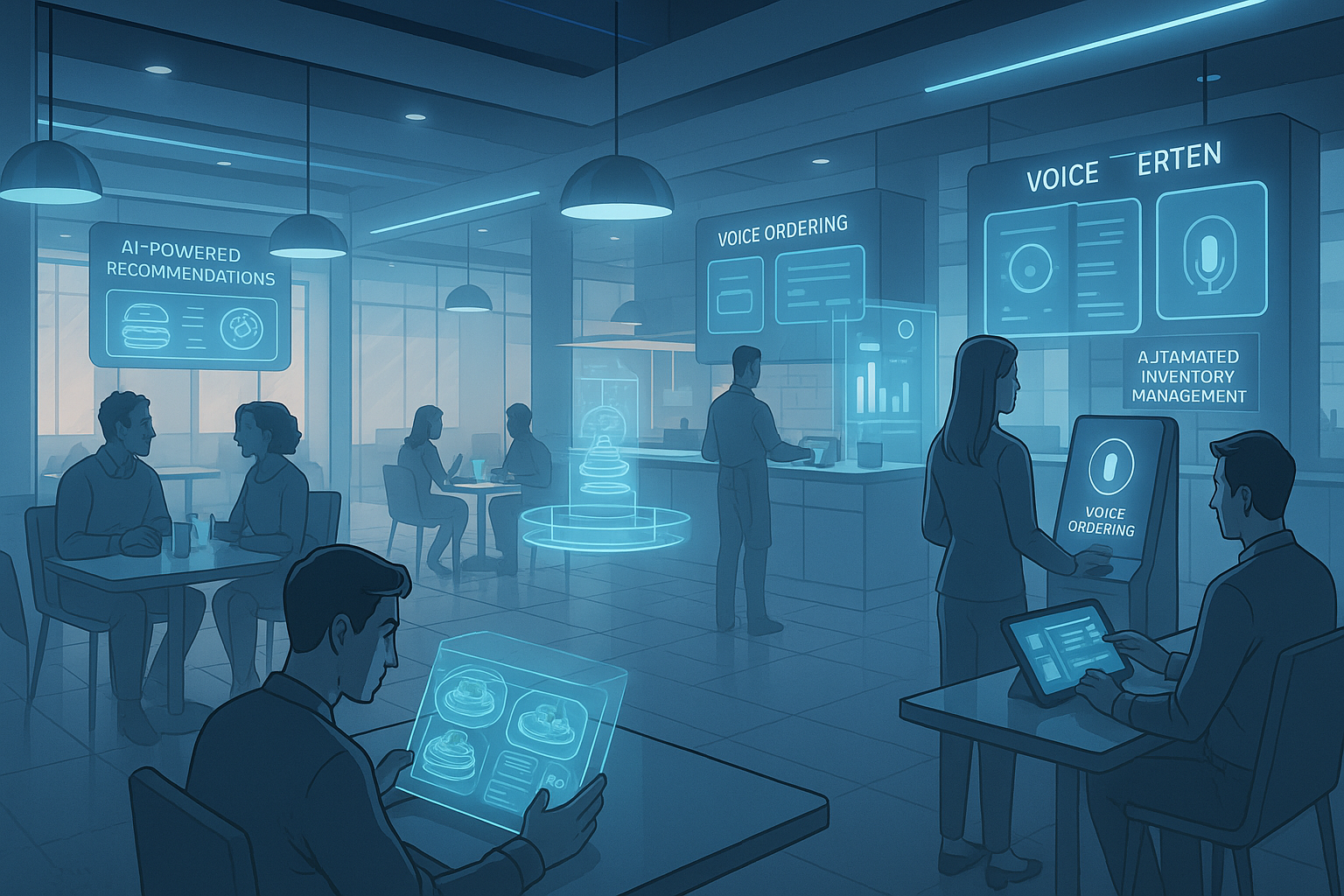
Emerging Technology Integration
Future restaurant technologies will build upon digital ordering foundations:
•AI-powered recommendations: Personalized menu suggestions
•Voice ordering: Integration with smart speakers and assistants
•Augmented reality menus: Interactive dining experiences
•Predictive analytics: Demand forecasting and optimization
Changing Consumer Expectations
Customer expectations continue evolving toward greater convenience and personalization:
•Instant gratification: Faster ordering and fulfillment
•Hyper-personalization: Customized experiences and recommendations
•Omnichannel experiences: Seamless interaction across all touchpoints
•Sustainability focus: Digital receipts and eco-friendly practices
Regulatory and Compliance Considerations
Future regulations may require digital capabilities for:
•Health and safety tracking: Contact tracing and health monitoring
•Tax compliance: Automated reporting and documentation
•Accessibility requirements: Digital accommodation for disabled customers
•Data protection: Secure handling of customer information
The Path Forward: Calculating Your Restaurant's Digital Ordering ROI
For restaurant owners still hesitant about digital ordering, the key is understanding the specific financial impact on their business.
ROI Calculation Framework
Use this framework to calculate your potential ROI:
1.Current monthly takeout revenue × 30% = Potential revenue increase
2.Current average order value × 15% = Potential order value increase
3.Monthly third-party commissions = Potential savings
4.Monthly phone order labor costs = Potential efficiency savings
5.Digital ordering system cost = Monthly investment
Example Calculation:
•Current takeout revenue: $20,000
•Potential increase (30%): $6,000
•Order value increase (15%): $3,000
•Commission savings: $3,000
•Labor savings: $1,500
•Total monthly benefit: $13,500
•System cost: $200
•Net monthly gain: $13,300
•Annual ROI: 79,800%
Implementation Timeline and Milestones
A typical digital ordering implementation follows this timeline:
Week 1-2: System setup and menu configurationWeek 3-4: Staff training and testingWeek 5-6: Soft launch with limited promotionWeek 7-8: Full launch and marketing campaignMonth 3: First ROI measurementMonth 6: Full optimization and expansion
Success Metrics to Track
Monitor these key performance indicators:
•Order volume growth: Month-over-month increase in total orders
•Average order value: Improvement in order size
•Customer acquisition: New customers gained through digital channels
•Customer retention: Repeat order rates and frequency
•Operational efficiency: Reduction in order-taking time and errors
Conclusion: The Cost of Inaction Is Too High to Ignore
The evidence is overwhelming: restaurants without digital ordering are losing money every single day they delay implementation. The financial impact extends far beyond simple revenue loss to encompass operational inefficiencies, competitive disadvantages, customer experience problems, and missed growth opportunities.
The question facing restaurant owners isn't whether they can afford to implement digital ordering—it's whether they can afford not to. With ROI timelines measured in months rather than years, and potential revenue increases of 30% or more, digital ordering represents one of the highest-impact investments a restaurant can make.
The restaurants that thrive in the coming years will be those that embrace digital transformation now, while those that continue to resist will find themselves increasingly marginalized in a market that demands convenience, efficiency, and seamless customer experiences.
The choice is clear: evolve or risk becoming irrelevant. The cost of staying offline is simply too high for any restaurant serious about long-term success and profitability.
Ready to stop losing money and start growing your restaurant's revenue? Contact humarazarya.com today to learn how our digital ordering solutions can transform your business and maximize your profits.

